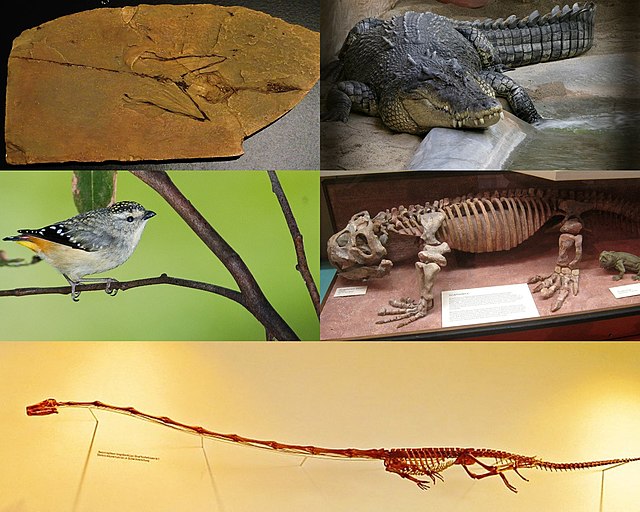Tanystropheus is an extinct genus of archosauromorph reptile which lived during the Triassic Period in Europe, Asia, and North America. It is recognisable by its extremely elongated neck, longer than the torso and tail combined. The neck was composed of 13 vertebrae strengthened by extensive cervical ribs. Tanystropheus is one of the most well-described non-archosauriform archosauromorphs, known from numerous fossils, including nearly complete skeletons. Some species within the genus may have reached a total length of 6 meters (20 ft), making Tanystropheus the longest non-archosauriform archosauromorph as well. Tanystropheus is the namesake of the family Tanystropheidae, a clade collecting many long-necked Triassic archosauromorphs previously described as "protorosaurs" or "prolacertiforms".
Tanystropheus
Type vertebrae of "Tanystropheus conspicuus", described in 1855
The flattened single-cusped skull of PIMUZ T 2819, a large morphotype (T. hydroides) specimen
PIMUZ T 2793, a lower jaw and associated vertebrae of T. hydroides
Archosauromorpha is a clade of diapsid reptiles containing all reptiles more closely related to archosaurs rather than lepidosaurs. Archosauromorphs first appeared during the late Middle Permian or Late Permian, though they became much more common and diverse during the Triassic period.
Archosauromorpha
An interaction between two archosauromorphs: Ornithosuchus ( a member of Archosauriformes) scavenging on Hyperodapedon (a rhynchosaur)
The skeleton of Protorosaurus, one of the oldest archosauromorphs and namesake of the problematic group "Protorosauria"
Champsosaurus, a gharial-like choristodere which survived the Cretaceous-Paleocene extinction event. Choristoderes may represent the fifth group of archosauromorphs, but their origin is obscured.








